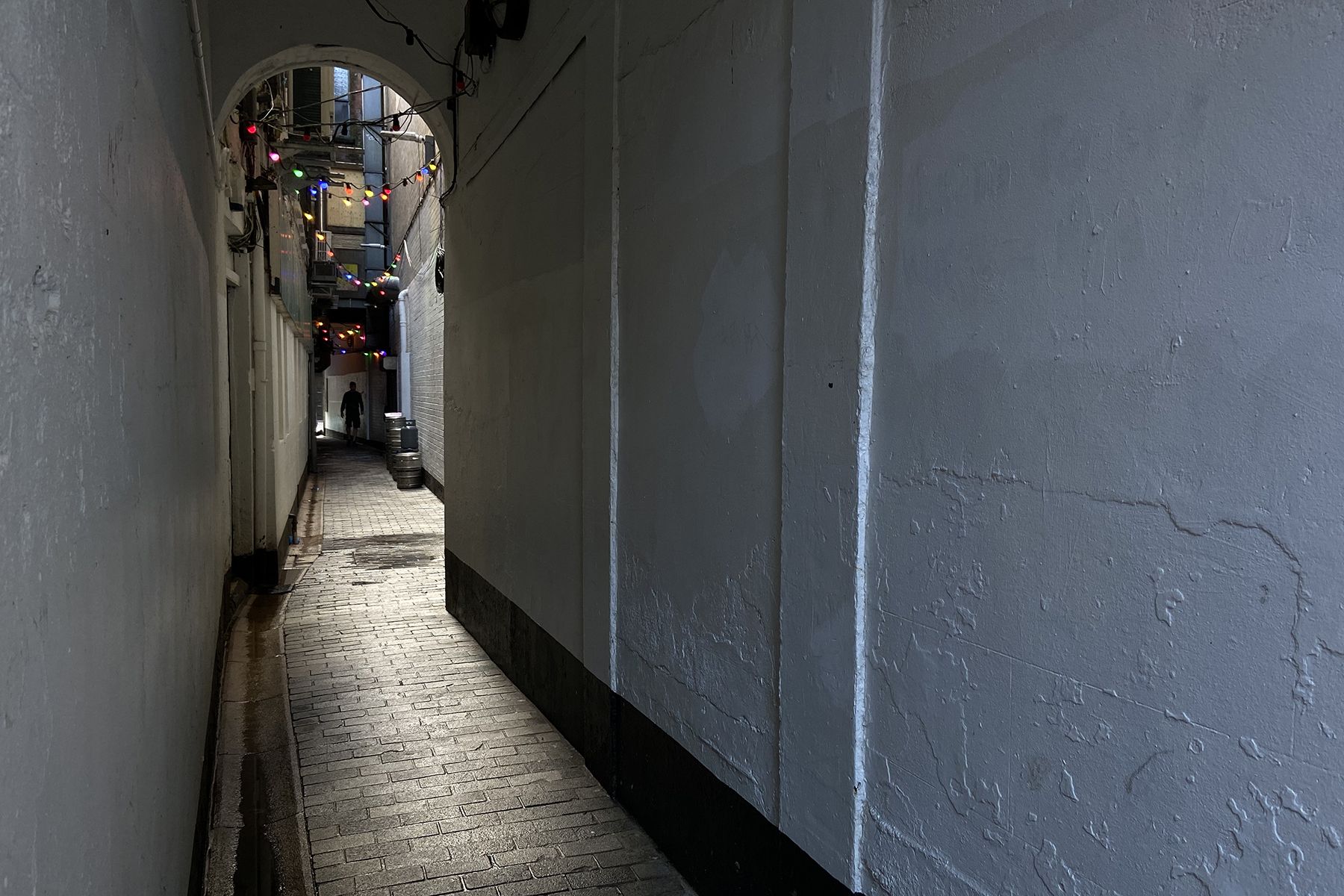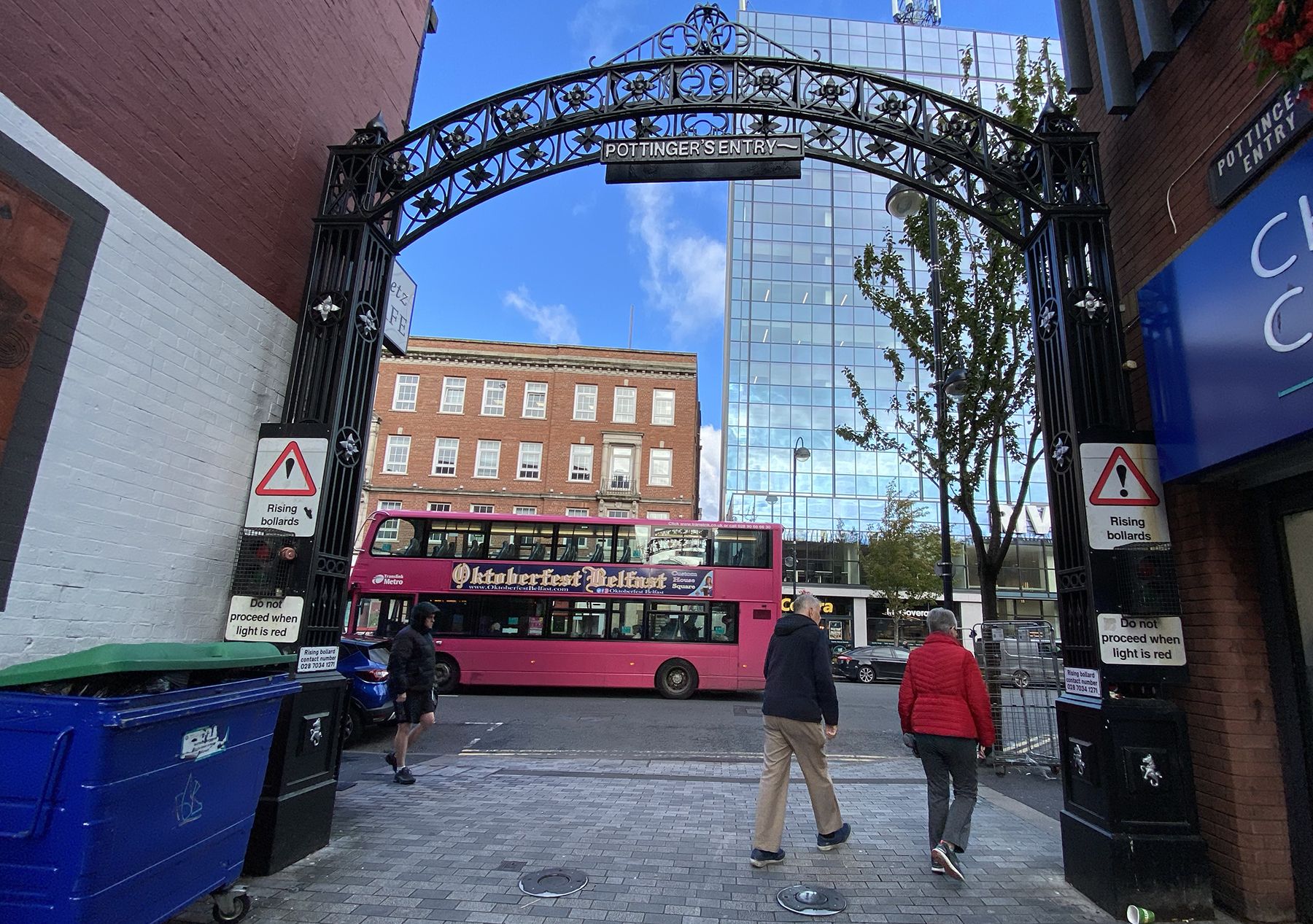IT'S difficult to imagine today but High Street and Ann Street, where Belfast’s population first settled after Arthur Chichester established a permanent settlement there in 1603, was once lined with houses with long front and rear tree-lined gardens, adjacent to the open flowing Farset River and nearby Lagan. Its population initially in its hundreds was by 1700 only 2,500 and by 1800 the population had grown to about 20,000.
With time and necessity spaces formed between rows of houses to allow free access between both High Street and Ann Street and from around 1630 some of these passages became purposely designed structures – ‘entries’. John Mac Lanachan’s map of 1715 shows two of these entries connecting High Street and Ann Street and these were the first of the constructed entries – Exchange Alley (later Joy’s Entry) and Pottinger’s Lane.
The Belfast Telegraph in 1923 said of the later 18th century: “The houses were generally low, though two and three storied buildings were springing up in High Street, and there were many slated roofs among the huddle of thatch. The streets were narrow and winding, while entries, cul de sacs and alleys threaded the town like a maze, and in some parts made a warren of it. Donegall Place was an aristocratic residential quarter with gardens and trees... Ann Street was the abode of comfortable merchants, who enjoyed their long gardens and the fields beyond.”
Belfast by the late 18th century had many entries, with the most well known in High Street and Ann Street, including Pottinger’s Entry, Winecellar Entry, Crown and Joy’s Entries, and Wilson’s Court. Less known about are Quin’s and Sugar House Entries, Blue Bell Entry and Caddell’s, Mitchell’s and Orr’s Entries. They were often called after prominent citizens of the day such as Joy, Telfair, Pottinger; or certain trades/businesses such as Winecellar or Sugar House Entries, Sweeps Entry, Weigh-House Lane or for their unfortunate ‘design’ Crooked Lane or Squeeze Gut Entry.
These Entries became places mainly for commerce and business, including shoemakers, cabinet makers, sedan chair businesses, printers, coopers, sweeps, clerks, etc. Telfair’s Entry in Ann Street was the location of Telfair’s Tobacco factory in the early 19th century. Many Belfast newspapers in the 19th century set up their premises in the Entries along High Street. The Belfast Commercial Chronicle was established in 1805 in Wilson’s Court; The Vindicator in 1839 at the Crown Entry/Ann Street corner; The Belfast Mercury in 1851 in Winecellar Entry and The Newsletter, Belfast’s first newspaper, established by Francis Joy in 1737, briefly had its premises in Joy’s Entry.
Joy's Entry
The High Street entries were valued more for their convenient location for commercial purposes than for social dwellings but over the years many people did live in them, owning or renting homes and most proprietors of the inns and taverns lived at their premises. The 1823 data contained in ‘George Benn’s History of Belfast’ revealed that as many as 191 people lived in Pottinger’s Entry, 170 people lived in Cadell’s Entry also in High Street, Graham’s Entry with 137 and Sugar House Entry (including Skipper Street),142 inhabitants.
The famous playwright and teacher James Sheridan Knowles for instance, lived in Crown Entry and taught English and elocution to his pupils there from 1811. The famous English portrait painter Thomas Robinson, spent seven years in Belfast – 1801/1808, and temporarily rented rooms in Quin’s Entry in High Street, which doubled up as his art studio. David Manson, the most famous teacher of his day in the 18th century, known as, ‘The Eminent Improver of Youth’ for his innovative teaching methods, initially used his house in Clugston Entry in High Street as a small school in 1755. He was honoured at the time of his death in March 1792 by holding his funeral by ‘torch light’ at midnight, (common in 18th century Belfast), the long procession passing along High Street and past the entry where he opened his first school, to his final resting place at St George’s Church.
‘The Narrow Streets’ were well known as locations for many taverns, inns, coffee and guest houses, places proliferated in the 18th and 19th centuries. The Northern Whig in 1868 revealed that Belfast, an area of 5,000 acres, had 535 licensed public houses and 102 spirit grocers. The newspaper expressed it so, “It would be difficult to throw a stone in Belfast without breaking a tavern window.” Not surprisingly drink-related offences in Belfast were very high. In 1866 ‘being drunk’ – 4,173 and ‘drunk and disorderly’ – 5573. Belfast never did have a healthy relationship with alcohol.
Winecellar Entry
In 1819 there were fifteen public houses in the High Street entries. One of these was the ‘Pottinger’s Arms Hotel and Coffee House’, at Pottinger’s Entry opened in 1845 by WJ Kearns. There was the Crown Tavern in Crown Entry. Another well-known tavern in Pottinger’s Entry was McMullans. John Smyth’s memoirs of life in Belfast during 1795-1810, written in 1868/1869 and published as ‘Belfast Sixty Years Ago, by an Octogenarian’, said of its reputation in the early 1800s, “Here was McMullan’s Tavern, devoted to fun and frolic, and boisterousness, in which the Belfast bucks had their club, and in which they revelled, and drank, and played such antics as need not be told in these sober times.”
The most famous tavern John Smyth recalled, was the “immortal Peggy Barclay’s Oyster House”, also known on its outside hanging signboard as the ‘Dr Franklin’. This was ‘Benjamin Franklin’ an eminent scientist and one of the American revolutionary leaders who led the war for independence from Great Britain. Smyth said of this, “Dr Franklin, awful and pompous, stood in a swinging frame over the door, telling all visitors, in my humble opinion, to eat, drink, and be merry, which they did. It was a large place for accommodation – there were twenty or thirty rooms... and in all Ireland there was no better rum than that hidden in Peggy’s cellars, an oyster supper was a substantial meal – formed a feast for the gods, especially when washed down with a reeking tumbler of rum, then the beverage of the day, and the particular boast of the mansion over which Dr Franklin kept watch and guard.”
Whilst the Corn-market and Church Lane markets were bustling, street entertainers and numerous ballad singers performed in and around the lanes and entries in the 18th and 19 centuries. The Northern Whig celebrated its centenary in January 1924, publishing many details of the social and cultural life in Belfast in the preceding 100 years. In Belfast some of the more notable were ‘Black Sam’ a street dancer and performer with his dancing dogs. ‘Cocky Bendy’ “a little bowlegged fiddler”, was a highly popular street entertainer, sometimes being hired for open air dances that lasted all night. There was also the well-known street musician the ‘Blind Fiddler’, who frequently played around the vicinity of North Street, High Street and Ann Street. To add to these popular street performers and eccentrics was the well-known Belfast linen merchant Hugh Graham from Carrick Hill, better known as ‘The Infant’, as he was seven feet tall. In the open markets among the crowds of buyers and sellers he was invariably the centre of attention with his towering frame and would be seen striding along High Street adding to the character of the town and likely the inn and taverns of the narrow alleys.
Wilson's Entry
The Newsletter of June 6th 1958 suggests that a small theatre called the ‘Vaults’, existed at least by 1753; likely an extension at the rear of a tavern in Ann Street, possibly between Crown Entry and Wilson’s Court. Various plays were performed there and the promotional literature of the period indicates that it was at that point when Shakespeare’s plays were introduced and first performed for Belfast audiences whatever the date when the Vaults first began as a theatre. These included Romeo and Juliet, Macbeth, As You like It, Richard III and Henry V. It’s most likely that patrons of the Vault’s Theatre after the shows had many a lively conversation in the convivial atmosphere of the inns and taverns located in the adjacent Entries and Courts.
During the earlier 19th century the sign-boards above the numerous taverns and hostelries became more flamboyant, which John Smyth in his memoirs described as the age of “sign and symbols”. There were very many, such as in Ann Street there was, ‘A Bird in the Hand is Worth Two in the Bush’; in Corn Market, ‘The Fruit Girl’ and ‘The Turk’s Head’; in Donegall Street there was ‘The Saddle Horse and Groom’; in Long Lane ‘The Monkey Shaving the Goat’ and ’The Cat and Fiddle’. Its signboard depicted the puss, “handling the bow in masterly fashion with an artistic ability calculated to cause all car-men with any pretence for a taste for music to make this house their temporary abode.”
The 1790s was a period when Belfast had a radical and democratic outlook amongst the Presbyterians and Catholic population. The Irish Volunteer Movement was influenced by the ideals of liberty and freedom of the French Revolution and the American War of Independence. It’s recorded that the United Irishmen met at Peggy Barclay’s under the guise of “The Muddler’s Club” and that the ‘Thatched House Tavern’ in Waring Street became the next meeting place when Peggy Barclay’s became too dangerous. The Thatched House Tavern had a suspended crown from the beam of a gibbet, “on the occasions of some rejoicing in honour of a French victory.”
Pottinger's Entry
On March 31st, 1906, The Fermanagh Herald, referring to Sugar House Entry stated: “The famous rendezvous of the leading spirits of the United Irishmen was there (Peggy Barclay’s Tavern).It was within that house that the principles of the movement of the United Irishmen were considered. Those present included, Henry Joy McCracken, Samuel Neilson and Thomas Russell, with a few more.”
This was likely the ‘Secret Committee’ that Wolf Tone described, i.e. the political leaders of the United Irishmen movement in Belfast and the principles referred to included the embrace of full equality for the rights of Protestant, Catholic and Dissenter and the achievement of National Liberty. The article acknowledged the historical, cultural and political significance of that meeting but also of the vicinity as the focal point of clandestine meetings, intrigue, and revered historical figures.“All about the district known, as Sugar House Entry was associated with historic memories.”
On the night of March 9th, 1793 in North Street a group of off duty ‘King’s Dragoons’ became angry at the ‘Blind Fiddler’ playing the French tune "Ça ira" (‘It'll be Fine’) – the most popular song of the French Revolution, to an appreciative crowd. The Dragoons demanded he stop and play ‘God Save the King’; a punch up ensued. More dragoons arrived and proceeded to wreck houses and shops with any ‘signs’ or ‘green’ emblems they disapproved off, including attacking the jewellers shop of Thomas McCabe, a sympathizer to the United Irishmen’s cause, smashing his famous shop signboard titled ‘The Irish Slave’. At Sugar House Entry they wrecked the signboard ‘Dr Franklin’ at Peggy Barclays and that of another tavern nearby, the ‘Mirabeau Inn’; Honoré Gabriel Riqueti, Count of Mirabeau, was a leader of the early stages of the French Revolution.
The Irish Volunteers summoned by trumpet from their homes to assemble, duly managing to defend the vicinity, forcing the Dragoons back to their barracks. The uniformed Volunteers reassembled on Sunday morning to guard the 3rd Rosemary Presbyterian Church, where the Rev Sinclair Kelburn, “preached to them in full uniform, with his gun laid across the pulpit cushion.”
These days the old Belfast entries retain their mystique, offering a potent evocation of our past. The Newsletter aptly said of the Entries in 1927, “So the recent past links up with times which now appear so far away. Belfast has grown vastly beyond the promise of those years; but so long as some of the old landmarks are allowed to remain, with their original names, so long shall we have pointers to the historic days when the city as we know it today was in the making.”
Brendan Muldoon© 2021




